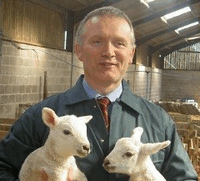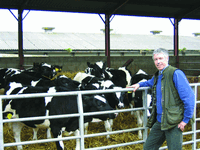Vet watch

Martin Peat
Cain Vet Group, Powys
Q With such a wet summer we have seen an increase in clinical cases of liver fluke this autumn. These have presented as a drop in milk yield, weight loss and diarrhoea in adult dairy cattle and as sudden death in a group of lambs.
Even farms not usually affected need to consider the possibility of infection this year. Discuss diagnosis and treatment/prevention with your vet.
As cattle are housed we are also seeing the seasonal rise in cases of pneumonia. It is worth considering whether cases can be prevented with improvements in housing and use of vaccines. Vaccination depends on various factors such as bugs on farm and age of calves.

John Macfarlane
Alnorthumbria Vet Group, Northumberland
Q “Calves and Kilos” has been our war-cry this autumn as we’ve progressed our DEFRA-funded North of England Cattle Health Initiative for beef farms. The aim has been to focus on producing a simple Health Plan which directly addresses farm profitability.
Our approach has been to establish a series of key production targets to assess individual farm performance, while screening culls and abortions for infections such as Johne’s, BVD, Neospora and Leptospirosis.
We have also tapped into pharmaceutical company sampling schemes, semen tested bulls and run trace mineral checks. This package has given nearly 100 beef farmers in NE England a unique and comprehensive review of the profit-limiting factors on their farms.

Steve Trickey
Chapelfield Vet Partnership, Norfolk
Q At a time when feed costs have increased and opportunities to buy cheap by-products or non human grade food are presented, take a little time to think whether this is the best thing to do.
One of my clients took delivery of some boxed sweet potatoes which were no longer suitable for the human market to feed to a group of Limousin cows. Over the course of a weekend, we lost six out of seven cows with signs of acute respiratory distress similar to fog fever, which did not respond to any treatment.
Death occurred between five and 12 hours after showing signs of respiratory distress.
Post mortems and testing of the sweet potatoes lead us to believe that a fungus on the skin of the potatoes was the cause of the deaths. So please check feed quality carefully.

Don Macmillan
Minster Vet Group, York
Anthelmintic resistance is one of the major problems facing the UK sheep industry. Slowing resistance should be a vital part of any flock health programme.
When there is so much sheep movement, effective quarantine strategies are essential, in particular quarantine drenching.
In many cases quarantine drenching is not being done properly because sheep are being given the incorrect dose. The weight of sheep is calculated incorrectly resulting in the wrong dose of wormer being given. It is, therefore, essential the correct advice is given when anthelmintics are dispensed, ensuring the most appropriate drug is used at the correct dose.
Q All participating vets are members of XLVets, a group of farm animal committed practices who work together, alongside commercial research and manufacturing companies. They aim to share best practice on advice and disease prevention initiatives.
